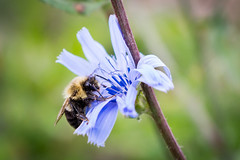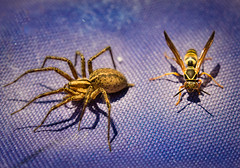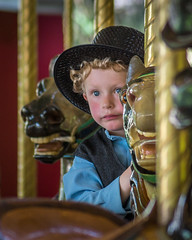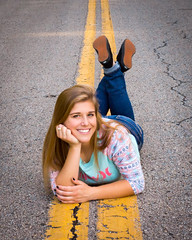Pops Digital
Carried Away by Love

Weddings seem perfect for black and white images. (White dresses, black tuxes.) This picture struck me as a good candidate. As you can see, I decided to leave a slight touch of color in the bride’s bouquet.
On their way to together forever, Aaron & Hannah McEnaney were married on June 4, 2011.
(A larger version of this photo may be viewed by clicking on it…especially if you have a large monitor.)
The Bride’s Bouquet

I had the honor of playing the role of Wedding Photographer at our son’s wedding. I took a ton of pictures and this is one of my favorites.
It was an outdoor wedding at the country home of the bride’s parents. The reception was held immediately following the ceremony in a tent on the property. (After a few posed photos of the wedding party and family.) At the head table, the gal’s bouquets were displayed in vases placed directly in front of each gal.
I decided to snap a closeup of the bride’s bouquet. While I was focusing and framing the shot, I noticed the groom having an intimate conversation with his bride. I don’t think they realized I was including them in this shot.
Even though the majority of the image is filled with gorgeous flowers in the foreground, your eyes are drawn to the blurred couple in the background.
I think this photo captures them…their couple personality…perfectly. (If you knew them you would think, “That is so them.”) Purposely keeping them out of focus conveys the intimacy of the moment and stirs the imagination. What do you suppose this groom is whispering to his bride?
(Click the image to see a larger version.)
Stormy Night Approaching

My wife said, “Come look at the sky; the colors are weird.”
As the sun was setting the evening of Wednesday, June 8, 2011 a storm front was moving in. Of course, I grabbed my camera. With a little digital magic I was able to capture the dramatic transition from peaceful sunset to stormy night.
My camera (Sony SLT-A55) has a mode it calls “Sweep Panorama” that stitches multiple photos together to make a larger image. I used it and got a nice image…but it wasn’t large enough to capture what was really happening. I could get some of the dark, angry clouds or some of the calmer sunset – but not both. The lens and photo frame were not large enough to fit the early evening drama in the same image.
In order to capture the full scene I wanted, I took five separate photos and stitched them together on my computer with a handy, free program from Microsoft called Image Composite Editor, or ICE.
As I said, this image is the composite of five individual shots. The final, combined image was over 100 mega pixels. And, as if that weren’t large enough, I actually tried to join 17 different individual photos together, but the final image turned out bent and distorted.
Here’s another view of the sky that evening.
I definitely recommend you view the larger images. To do so, just click the photos.
Feel free to leave a comment and if you like the image, share it with others.
Early Bloomer
Like a Dream

This is my favorite hummingbird photo of the year…so far. I’ve been trying to capture the hummingbirds that frequent the feeders at our house this spring. I’ve been able to grab a few images that I’ve liked. However, the best of them have been images of birds perched on a feeder. (See my earlier posts – Intense Eater and All Puffed Up)
My ultimate photographic goal is to capture them in flight. I want to freeze their little wings so that you can see the detail of every feather. (A nearly impossible task for an amateur like me.)
This photo doesn’t achieve my ultimate goal – to capture the detail of the hummingbird’s wings – but it captures my soul. I don’t want this to come across as bragging. I realize not everyone will find this image as compelling as I do. (Beauty is in the eye of the beholder, right?) But to this beholder, this image is like something from a dream.
I took this in the early morning light (around 5 am). The angle and quality of the sunrise lighting gives it depth. I think the colors are wonderful. The bird’s head being in focus while the rest of the body is slightly out of focus draws your attention to it’s stare; it’s character. (I also love its little feet.) Add the background blur and the whole image takes on an artistic quality. The overall effect reminds me of a watercolor painting.
Adding to the wonder of it all (at least for me) is the fact that I did very little to this image in post-processing. Aside from cropping and increasing the contrast a smidge, this is the image that came out of the camera. (My Sony SLT-A55 with the standard kit lens.)
This is one you’ll want to see closer. Just click on the photo to view a larger version.
All of the photos I post are available for purchase. If you’d like to buy one, click on the blue “Buy this Online” bar below for a variety of print and frame options or contact me for digital purchase and licensing options.
One Crazy, Swingin’ Red Head

 This is a Pileated Woodpecker. These birds are huge. It’s become a regular visitor to the jumbo suet feeder in our yard. The jumbo feeder is about 5 times the size of a normal suet feeder, and this bird makes it look small. The feeder hangs from a tree limb and acts like a swing when this big bruiser is hanging on.
This is a Pileated Woodpecker. These birds are huge. It’s become a regular visitor to the jumbo suet feeder in our yard. The jumbo feeder is about 5 times the size of a normal suet feeder, and this bird makes it look small. The feeder hangs from a tree limb and acts like a swing when this big bruiser is hanging on.
These are strange looking birds. It’s believed a Pileated’s red crest and sound was inspiration for the cartoon character Woody Woodpecker.
According to Wikipedia.org – – The Pileated Woodpecker (Dryocopus pileatus) is a very large North American woodpecker, almost crow sized, inhabiting deciduous forests in eastern North America, the Great Lakes, the boreal forests of Canada, and parts of the Pacific coast. It is also the largest woodpecker in America.
The call is a wild laugh, similar to the Northern Flicker. Its drumming can be very loud, often sounding like someone striking a tree with a hammer. This bird favors mature forests, but has adapted to use second-growth stands and heavily wooded parks as well.
(Click on an image to view a larger version.)
All Puffed Up

It was about 5:30 am on a cool Wisconsin spring morning – 37 degrees. This female ruby-throated hummingbird paused in the early morning sun and puffed up her feathers in an effort to stay warm. Of course, she was only there for a few moments before zipping away again.
(You may be able to see a larger version of this image by clicking on it.)
Intense Eater

I had a few minutes before I had to shuffle off to work this morning. I decided to sit still by the window and try to grab a good hummingbird photo or two.
This is a male ruby-throated hummingbird intent on downing his breakfast. I love the way the low angle of the sun strikes and highlights the tiny feathers.
This is one of three good images I captured in this 15 minute setting. I’ll post the others soon, so check back.
Feel free to share this image with friends.
(Click the photo to view a larger version.)
The Blues in Double Time

On a dreary, rainy spring morning I was delighted to see four Indigo Buntings flitting around the bird feeders in my yard. I started snapping pictures, hoping to get some good images. I was never able to catch an image of the Indigos together. The birds in this shot are actually the same bird – brought together with the magic of Photoshop.
 Most times I use Photoshop to tweak my photos – to crop, straighten, correct the color, etc. Some times I use it to create an entirely different image than what I started with. Here’s the basic process for this double Indigo image. Remember, all the Indigos in these images are the same bird, just captured in different locations.
Most times I use Photoshop to tweak my photos – to crop, straighten, correct the color, etc. Some times I use it to create an entirely different image than what I started with. Here’s the basic process for this double Indigo image. Remember, all the Indigos in these images are the same bird, just captured in different locations.
I started with photo 1. I straightened it, enlarged it and cropped it. I also did a little work to clean up some of the white spots of bird poop on the side of the feeder that you don’t notice on the small version but would be ugly when enlarged.
Time to add another Indigo Bunting to the image. I isolated the Indigo Bunting on his perch from photo 2 and copied and pasted it to photo 1. I had to scale the second bird to proper proportions and overlay it over the perch on the opposite side of the first bird. Then I cropped it to the image you see as photo 3.

Looking at photo 3, I decided that the Goldfinches were a distraction, so I removed them by cloning parts of the feeder and surrounding background over them.
Things were looking pretty good, but I decided that the image was wider than I really wanted. To change it’s overall proportions I narrowed the feeder, bringing the birds closer together.
After tweaking the contrast and sharpness the project was complete. I hope you like it.
A few days later it dawned on me – I could have created an image with the feeder full of Indigo Buntings. Maybe I’ll work on that when I’m stuck in the house on a cold winter’s day, wishing I could be out photographing birds.
(Click on the main image for a larger view.)
Water Wings

I took this photo at a small wetland area on my drive home. They were closer and on dry ground when I drove up, but as soon as the mama spotted me, she took the kids for a safe swim.
Canada Geese have become so prolific they are often considered a nuisance…but how can you not love the goslings. I counted 11 little ones in this brood.
(Click the image to view a larger version.)





















































